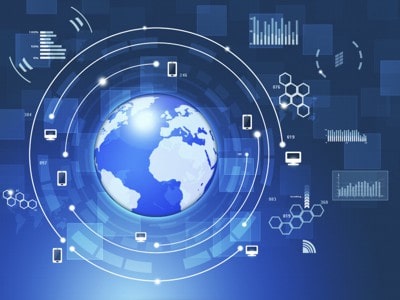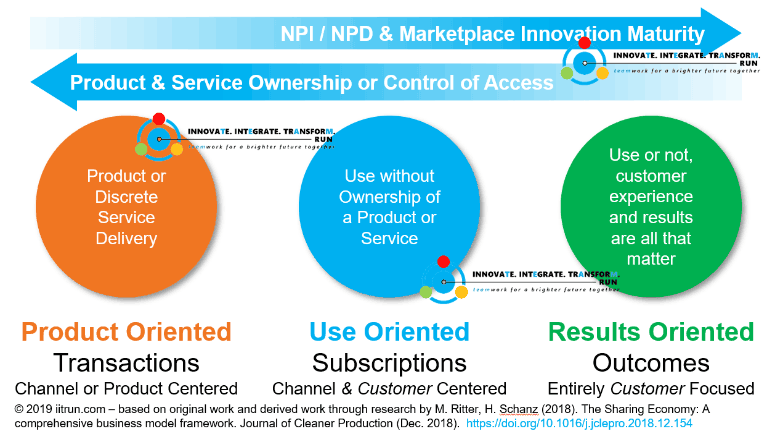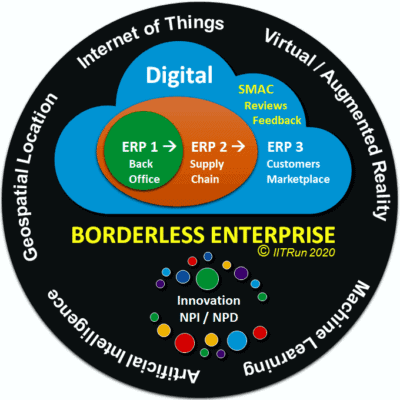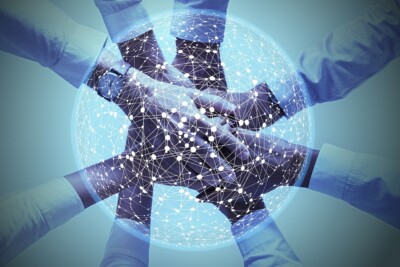
On the Digital Business Transformation journey, our first step was identifying key reasons Why So Many Struggle with Digital Transformation. After that, we explored Defining Digital Business for understandable goals and insight.
In this post, we introduce a modern Digital Business Model based on years of practical experience and peer-reviewed research. Our next posts discuss successful Digital Journey delivery and execution techniques.
Research and Our Future Digital Business Transformation Model
Because the future of your business depends on customers and markets, getting them integrated into what we call the “Borderless Enterprise” or, ERP III, is a critical component of your Digital Journey. Peer-reviewed research trends are aligning with our field experience on the ERP III Digital Bridge to your customers and markets. Below is an example application of the customer and marketplace focus that our digital transformation business model proposes. As you work from left to right, notice that customer experience and customer integration take a more prominent role. Business models change from discrete transactions to more of an integrated customer experience Digital Business Model.

How Business Models are Changing in the New Customer Experience Use Based and Subscription Economy
A maturing business model moves from ownership, to user-ship, and then to experience. These are additional sales and marketing channels. A large segment of the customer population will always want to own a tangible product, or just want to execute a transaction. Many mixed business models may also have the same customer interact with your enterprise in more than one of these models, forming an omni-channel capability. You may also disrupt existing models in the transition. Ultimately, each journey is different.
Digital Is All About Your Customer and Market
A customer- and market-focused approach to business and technology is not about some new CRM system. Even though CRM may be a component, the focus is on marketplace transformation more than managing your sales force. Our ERP III Digital Business Model converges business, IT, and the broader marketplace with sales and the customer at the center of your enterprise. While technology is an enabler, digital is an approach to business.
Digital is not about specs, coding, system settings, or other technical skills. Rather, Digital Business is about discovering opportunities and solving problems affecting your customers and markets.
We like simple pictures of models that explain complicated concepts. After all, these visuals more easily improve understanding. We have a simple but illustrative digital business reference model for this insight:

ERP III Digital Business Model
As our Digital Business Model shows, Digital is part of the core enterprise ERP capability. By focusing on customers and markets through Social, Mobile, Analytics, and Cloud (SMAC), and then combining that with customer reviews and feedback, you build those ERP III Borderless Enterprise bridges with your customers. Your New Product Innovation/Introduction (NPI) experience positive impacts, as well as New Product Development (NPD). That SMAC plus feedback loop enables you to innovate better products or services. In turn, you build stronger connections with customers and the marketplace.
Combine a customer-centered foundation with the Analytics and Cloud (A and C in SMAC), and you now have the ingredients for success in Machine Learning, Artificial Intelligence, VR/AR, IoT, Geospatial technologies, or other endeavors. These technologies combine to form digital capabilities to meet the needs of your customers and the marketplace. Look at how each one impacts your customers and markets:
- IoT for device awareness, customer usage, and possibly service integration. This may allow for eventual automated marketing tailored to each customer.
- Geo-Location for understanding customer differences by geography for targeted sales and marketing.
- AR/VR for customer experience. Immerse them in your product or service and gather market intelligence.
- Machine learning to take advantage of analytic data and support Artificial Intelligence.
The reference model is what is important, not necessarily the specific technologies it contains (although these are good examples). The model is meant to provide an example of technologies that touch your customers and allow for greater participation in your enterprise while you gain market insight. The bridge technologies you use to integrate customers into your enterprise may be different. They may contain CPQ (Configure, Price, Quote), some sort of self-service integration, chatbots, etc. The idea is to define the technologies and channels with the greatest impact on your customers and markets.
The Digital Roadmap to the Future
This definition and approach to digital provides an easy-to-understand Digital Business Model for evaluating your strengths and weaknesses. It moves past the consulting and analyst hype about digital being any and all technology solutions while providing a reference for building your roadmap.
Next, we will look at where to start and how to free up capital for your journey through technical debt reduction. By focusing on simplification, modernization, and management capabilities, you can provide a compelling case and roadmap for short-, mid-, and long-term success!





